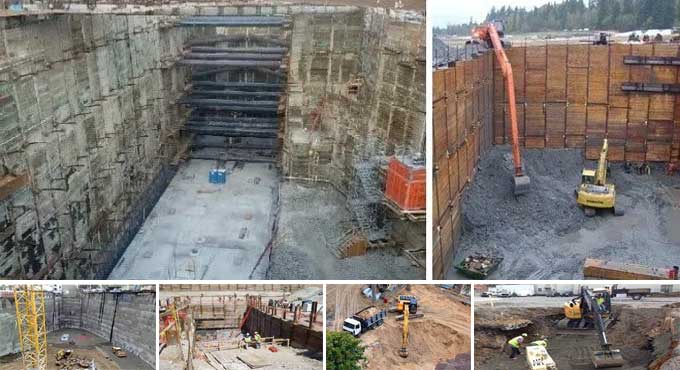
Methods of excavation commonly used for basements
Buildings are built on foundations, which are buried in the earth and hold up the structures that sit atop them. Structures are supported by foundation walls, which are usually made of concrete, brick, or cinder blocks. A basement is the lowest part of a building's foundation when it has one.
It is one of the most expensive parts of home construction to lay the foundation, regardless of whether your home has a basement or just a crawl space. As crucial as it is, it must also be done correctly. Buildings lack structural integrity and are unsafe to occupy without a proper foundation.
How does basement excavation work?
In order to create a basement, dirt, rock, and other debris must be removed. In most cases, it is the first step in the construction process, as excavated soil gets displaced, resulting in a hole in the ground where the basement will be constructed.
An excavation of a basement can also take place after the construction of a house. A seasoned excavation contractor is required for this type of work because he must dig into the ground and haul away the excavated materials without damaging your building's foundation, footings, or floor joists. Before any part of a building is constructed, it is ideal to dig out the basement to reduce excavating costs.
Excavation of basements: 5 common methods
A basement can be excavated using five noteworthy construction methods, depending on its nature.
The Bracing Method
While bracing is more expensive than open-cut excavations, it is more economical than top-down excavations. The foundation is supported by horizontal struts installed in front of the wall, which transfers weight from the retaining wall to the foundation.
It is possible to use these horizontal struts to construct an entire basement in your building if they are properly spaced out.
As with a top-down system, horizontal struts are an excellent way to reduce strain on the retaining walls, although they are not as strong or foolproof as a full concrete floor bolted to the foundation.
For homeowners and builders priced out of the top-down method of bracing due to the cost factors and the lower complexity of the bracing method, it is an attractive choice.
The Top Down Method
A high-rise building in an urban area is often constructed by using this excavation method in order to construct the building. The process begins with the construction of load-bearing foundation walls and the laying of a concrete ground floor on top of them.
The ground floor is excavated, followed by a large often complex basement. Despite being more expensive, this method allows a basement to be excavated while the upper floors of the building are being built.
The Anchored Method
An excavation method using steel anchors involves driving them into the soil and running them through the retaining wall. In addition to providing stability to the overall structure, the earth anchoring force also enables excavations to proceed swiftly and safely.
Only bedrock or extremely dense clay will work as anchors in the anchored method. In sandy or clay soil, anchors cannot be braced due to their softness.
The Island Method
Basements are excavated from the inside out using the island method. Excavated areas can be cleared using this method in a safe manner. A section of the basement is excavated near its center in this method.
Following excavation, the excavated materials are laid on a slope near the structure's retaining walls. Eventually, the center structure will be braced to the outer walls as the slope continues. Finally, using the island method creates a safe and strong basement by combining elements of both open-cut slope and bracing methods.
Choosing the right method for basement excavation
Project owners and excavating contractors on the job will decide how to excavate a basement. Consider the following factors when selecting your excavation method.
1. The type of soil present: Soil quality and density play a critical role in the excavation of buildings. You will need to dig deep into the earth if you are building on sandy soil in order to secure your structure properly. It is therefore necessary to use an open-cut cantilever method, which permits deep excavation. The slope method could work if you are excavating on clay soil that is dense.
2. The Variety of the construction: Having a fresh plot of land to build on makes excavating a basement easier. Additionally, it will make excavations more affordable and faster. Under existing buildings, you will have fewer options if you plan to excavate a basement. A structural engineer and excavating contractor must be consulted before any excavation takes place.
You do not want to carry out any construction that will jeopardize the integrity of your structure because building foundations are no joke.
To get more details, watch the following video tutorial.
Video Source: Daz Sibanda
3. The actual size of your building: The top-down method is typically used to excavate tall skyscrapers and office buildings. Unlike bracing or open-cut methods, this method allows a builder to work quickly and ensure greater stability early on. In general, top-down excavation is more expensive than bottom-up excavation. Consider other options, such as the island method, if your ambitions are simpler.
4. The topography or the place of your construction project: Your retaining walls will be put to extra useful if you are building on a hillside. As you excavate, the earth may play a role in keeping your walls stable, requiring you to use the anchored method of excavation.

The idea of digging a basement into the ground will be eliminated by a steep slope. Building on a flat piece of land gives you more options. In addition, consider the water table. If the water table is near the surface, you will have to pump water if you want to go too deep.

